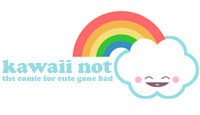Kawaii is the Japanese flavor of cute, made famous by Hello Kitty and her softly rounded, mostly nonthreatening colleagues (my favorites are the San-X characters, all of which are slightly twisted in interesting ways).
In Japan, these cartoon characters can decorate everything from cell phone charms to checkbooks and cars. In Meghan Murphy’s world, they talk back.
Murphy’s Kawaii Not takes kawaii and gives it some bite. Murphy appropriates not only the Japanese concept of cute but also the 4-koma format, a four-panel gag strip that runs vertically rather than horizontally.  But there’s something very American about her straight-talking hearts, ice-cream cones, and even toilets; each strip starts out cute and ends with a twist.
But there’s something very American about her straight-talking hearts, ice-cream cones, and even toilets; each strip starts out cute and ends with a twist.
Murphy is a professional illustrator by day; her work can be seen at her professional site, Murphypop. We decided to talk to her about what makes Kawaii Not tick.
Digital Strips: How did you get the inspiration for Kawaii Not?
Meghan Murphy: I developed this bizarre and wonderful fascination for that particular style cute characters/mascots/whatever that derives cuteness from the simple application of a smiley face to something that usually doesn’t have one. I’d been wanting to try my hand at a webcomic, when one day the title just kinda came to me. Then I had to do something with it.
Â
 DS: Why did you choose the 4-koma format, and what are the challenges of working with it?
DS: Why did you choose the 4-koma format, and what are the challenges of working with it?
MM: I was  inspired by comics I was reading at the time, particularly Azumanga Daioh—and decided that the vertical-ness of that format could work quite well online, what with all the scrolling down and such. The biggest challenge was (and often still is) finding the best way to tell a story/joke in a four panel setting, just trying getting the rhythm right. I’m learning, I think.
DS: A lot of the humor in Kawaii Not comes from a cute object saying something that’s contradictory, rude, or brutally true. How do you balance that tension between cuteness and edginess?
MM: I’ve found that much of the balance is inherent in the juxtaposition of the cute and the naughty. Put a little happy face on something and you can make it say something completely and utterly wrong, but damn it all if you still don’t find the little guy cute. It’s kind of a “Get Out of Jail Free” card in that way.
DS: The look of Kawaii Not has been very consistent over the time you have been doing it, although it seems like some of the icons are more complex—I’m thinking of the caramel macchiato in the most recent strip, as opposed to the hearts and farts of your earlier comics. How do you draw Kawaii Not, and has your technique evolved?
MM: A typical Kawaii Not starts as a little rough drawing and scribbled note somewhere in one of my sketchbooks. I usually have quite a few bubbling away, in a not-quite-right-yet state, waiting until one day I look over a particular notion and I finally figure out what it needs to work as a strip. I refine the sketch a little, then scan it into the computer, and finish the final art in Illustrator.
I know I have definitely become more comfortable playing around in this style, which is what probably has led to the more involved designs that some of my later strips have had. But I really do try to keep it at a certain level of clean-and-simple. Well, maybe “clean” isn’t the right word.
DS: Finally, the question on every webcomics artist’s mind: Are you making any money from Kawaii Not, and if so, how?
MM: Surprisingly (to me anyway), I do make more than I spend on Kawaii Not right now. Which is pretty cool. The 1 inch buttons I offer on my site are quite popular—which I figure is because they are the perfect mix of fun and cheap (one of my favorite combos.) I have also recently started offering t-shirts, and of course I have been lucky enough to have the Kawaii Not book published this year. So having a few different “ventures” going on at once has worked well for me so far.
